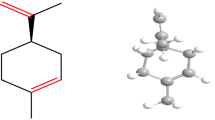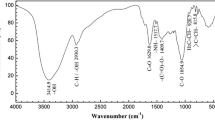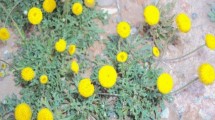Abstract
Current research efforts now focus on the development of novel, cheaper, nontoxic, highly efficient and eco-friendly corrosion inhibitors as alternatives to different inorganic and organic compounds. In this context, orange zest essential oil (OZEO) was investigated as corrosion inhibitor for mild steel in 1 M HCl medium utilizing different techniques such as gas chromatography–mass spectrometry (GC–MS), mass loss, electrochemical and scanning electron microscope (SEM) associated with energy-dispersive X-ray spectroscopy (EDX). The obtained results indicated that this OZEO acted as an efficient corrosion inhibitor and the inhibition efficiency reached up to 75.64% at 2.5 g L−1 of OZEO. The potentiodynamic curves revealed that OZEO acted as mixed inhibitor with a predominantly anodic action, facilitating the formation of an adsorbed film over the mild steel surface. The adsorption data is fitted to Langmuir, Flory–Huggins, Freundlich, El-Awady, Temkin, Frumkin, Langmuir–Freundlich and Dubinin–Radushkevich isotherms models and involve chemisorption mechanism. SEM examination and EDX analysis of the mild steel surface confirmed the existence of a protective adsorbed film.
















Similar content being viewed by others
References
Mobin M, Rizvi M (2017) Adsorption and corrosion inhibition behavior of hydroxyethyl cellulose and synergistic surfactants additives for carbon steel in 1 M HCl. Carbohydr Polym 156:202–214. https://doi.org/10.1016/j.carbpol.2016.08.066
Agi A, Junin R, Zakariah MI, Bukkapattanam TB (2018) Effect of temperature and acid concentration on Rhizophora mucronata tannin as a corrosion inhibitor. J Bio- Tribo-Corros 4:5. https://doi.org/10.1007/s40735-017-0121-0
Raja PB, Qureshi AK, Abdul Rahim A et al (2013) Neolamarckia cadamba alkaloids as eco-friendly corrosion inhibitors for mild steel in 1 M HCl media. Corros Sci 69:292–301. https://doi.org/10.1016/j.corsci.2012.11.042
El Assiri EH, Driouch M, Bensouda Z et al (2019) Analytical & relationship between corrosion inhibition efficiency and derivatives on C-steel surface. Anal Bioanal Electrochem 11:373–395
Tan KW, Kassim MJ, Oo CW (2012) Possible improvement of catechin as corrosion inhibitor in acidic medium. Corros Sci 65:152–162. https://doi.org/10.1016/j.corsci.2012.08.012
El Assiri EH, Driouch M, Bensouda Z et al (2018) Quantum chemical and QSPR studies of bis-benzimidazole derivatives as corrosion inhibitors by using electronic and lipophilic descriptors. Desalin Water Treat 111:208–225. https://doi.org/10.5004/dwt.2018.22198
Rani BEA, Basu BBJ (2012) Green inhibitors for corrosion protection of metals and alloys: an overview. Int J Corros 2012:1–15. https://doi.org/10.1155/2012/380217
Ostovari A, Hoseinieh SM, Peikari M et al (2009) Corrosion inhibition of mild steel in 1 M HCl solution by henna extract: a comparative study of the inhibition by henna and its constituents (Lawsone, Gallic acid, α-d-Glucose and Tannic acid). Corros Sci 51:1935–1949. https://doi.org/10.1016/j.corsci.2009.05.024
Faustin M, Maciuk A, Salvin P et al (2015) Corrosion inhibition of C38 steel by alkaloids extract of Geissospermum laeve in 1 M hydrochloric acid: electrochemical and phytochemical studies. Corros Sci 92:287–300. https://doi.org/10.1016/j.corsci.2014.12.005
Bouyanzer A, Hammouti B, Majidi L (2006) Pennyroyal oil from Mentha pulegium as corrosion inhibitor for steel in 1 M HCl. Mater Lett 60:2840–2843. https://doi.org/10.1016/j.matlet.2006.01.103
Khadraoui A, Khelifa A, Hadjmeliani M et al (2016) Extraction, characterization and anti-corrosion activity of Mentha pulegium oil: weight loss, electrochemical, thermodynamic and surface studies. J Mol Liq 216:724–731. https://doi.org/10.1016/j.molliq.2016.02.005
Chraibi M, Benbrahim KF, Elmsellem H et al (2017) Antibacterial activity and corrosion inhibition of mild steel in 1 M hydrochloric acid solution by M. piperita and M. pulegium essential oils. J Mater Environ Sci 8:972–981
Salhi A, Bouyanzer A, El Mounsi I et al (2016) Chemical composition, antioxidant and anticorrosive activities of Thymus algeriensis. J Mater Environ Sci 7:3949–3960
Hamdani I, El Ouariachi E, Mokhtari O et al (2017) Chemical constituents and corrosion inhibition of mild steel by the essential oil of Thymus algeriensis in 1.0 M hydrochloric acid solution. Der Pharma Chem 8:252–264
Bammou L, Chebli B, Salghi R et al (2010) Thermodynamic properties of Thymus satureioides essential oils as corrosion inhibitor of tinplate in 0.5 M HCl: chemical characterization and electrochemical study. Green Chem Lett Rev 3:173–178. https://doi.org/10.1080/17518251003660121
Taoufik F, Anejjar A, Asdadi A et al (2017) Synergic effect between Argania spinosa cosmetic oil and Thymus satureioides essential oil for the protection of the carbon steel against the corrosion in sulfuric acid medium. J Mater Environ Sci 8:582–593
El Ouadi Y, Lahhit N, Bouyanzer A, Elmsellem H, Majidi L, Znini M, Abdel-Rahman I, Hammouti B, El Mahi B, Costa J (2016) The use of essential oil of thymus capitatus originating from north-east morocco, as eco-friendly corrosion inhibitors of mild steel in hydrochloric acid solution. Int J Dev Res 6:6867–6874
Boumhara K, Tabyaoui M, Jama C, Bentiss F (2015) Journal of Industrial and Engineering Chemistry Artemisia Mesatlantica essential oil as green inhibitor for carbon steel corrosion in 1 M HCl solution: electrochemical and XPS investigations. J Ind Eng Chem 29:146–155. https://doi.org/10.1016/j.jiec.2015.03.028
Elbouchtaoui MC, Anejjar A, Salghi R et al (2014) Inhibition of steel corrosion in 1 M HCl by the essential oil of Thymus pallidus. Der Pharma Chem 6:406–414
Houbairi S, Essahli M, Lamiri A (2013) Inhibition of copper corrosion in 2 M HNO3 by the essential oil of thyme morocco. Port Electrochim Acta 31:221–233. https://doi.org/10.4152/pea.201304221
Bensouda Z, Driouch M, Belakhmima RA et al (2018) Thymus sahraouian essential oil as corrosion eco-friendly inhibitor for mild steel in a molar hydrochloric acid solution. Port Electrochim Acta 36:339–364. https://doi.org/10.4152/pea.201805339
Znini M, Cristofari G, Majidi L et al (2012) Green approach to corrosion inhibition of mild steel by essential oil leaves of asteriscus graveolens (Forssk.) in sulphuric acid medium. Int J Electrochem Sci 7:3959–3981
Znini M, Majidi L, Bouyanzer A et al (2012) Essential oil of Salvia aucheri mesatlantica as a green inhibitor for the corrosion of steel in 0.5 M H2SO4. Arab J Chem 5:467–474. https://doi.org/10.1016/j.arabjc.2010.09.017
Lahhit N, Bouyanzer A, Desjobert J-M et al (2011) Fennel (Foeniculum Vulgare) essential oil as green corrosion inhibitor of carbon steel in hydrochloric acid solution. Port Electrochim Acta 29:127–138. https://doi.org/10.4152/pea.201102127
Halambek J, Berković K, Vorkapić-Furać J (2010) The influence of Lavandula angustifolia L. oil on corrosion of Al-3 Mg alloy. Corros Sci 52:3978–3983. https://doi.org/10.1016/j.corsci.2010.08.012
Zerga B, Sfaira M, Rais Z et al (2009) Lavender oil as an ecofrindly inhibitor for mild steel in 1 M HCl. Matériaux Tech 97:297–305. https://doi.org/10.1051/mattech/2009045
Benabdellah M, Benkaddour M, Hammouti B et al (2006) Inhibition of steel corrosion in 2 M H3PO4 by artemisia oil. Appl Surf Sci 252:6212–6217. https://doi.org/10.1016/j.apsusc.2005.08.030
Bendahou M, Benabdellah M, Hammouti B (2006) A study of rosemary oil as a green corrosion inhibitor for steel in 2 M H3PO4. Pigment Resin Technol 35:95–100. https://doi.org/10.1108/03699420610652386
Mourya P, Banerjee S, Singh MM (2014) Corrosion inhibition of mild steel in acidic solution by Tagetes erecta (Marigold flower) extract as a green inhibitor. Corros Sci 85:352–363. https://doi.org/10.1016/j.corsci.2014.04.036
McCafferty E (2005) Validation of corrosion rates measured by the Tafel extrapolation method. Corros Sci 47:3202–3215. https://doi.org/10.1016/j.corsci.2005.05.046
Zhang K, Yang W, Yin X et al (2018) Amino acids modified konjac glucomannan as green corrosion inhibitors for mild steel in HCl solution. Carbohydr Polym 181:191–199. https://doi.org/10.1016/j.carbpol.2017.10.069
Zarrok H, Zarrouk A, Hammouti B et al (2012) Corrosion control of carbon steel in phosphoric acid by purpald—weight loss, electrochemical and XPS studies. Corros Sci 64:243–252. https://doi.org/10.1016/j.corsci.2012.07.018
Aourabi S, Majid D, Kenza A et al (2018) Evaluation of anticorrosion and antioxidant activities of ethanolic extract of ammi visnaga. Anal Bioanal Electrochem 10:912–929
Bagga MK, Gadi R, Yadav OS et al (2016) Investigation of phytochemical components and corrosion inhibition property of Ficus racemosa stem extract on mild steel in H2SO4 medium. J Environ Chem Eng 4:4699–4707. https://doi.org/10.1016/j.jece.2016.10.022
Satapathy AK, Gunasekaran G, Sahoo SC et al (2009) Corrosion inhibition by Justicia gendarussa plant extract in hydrochloric acid solution. Corros Sci 51:2848–2856. https://doi.org/10.1016/j.corsci.2009.08.016
Solmaz R (2014) Investigation of adsorption and corrosion inhibition of mild steel in hydrochloric acid solution by 5-(4-dimethylaminobenzylidene)rhodanine. Corros Sci 79:169–176. https://doi.org/10.1016/j.corsci.2013.11.001
Beniken M, Driouch M, Sfaira M et al (2018) Anticorrosion activity of a polyacrylamide with high molecular weight on C-steel in acidic media: part 1. J Bio- Tribo-Corros 4:38. https://doi.org/10.1007/s40735-018-0155-y
Li L, Zhang X, Lei J et al (2012) Adsorption and corrosion inhibition of Osmanthus fragran leaves extract on carbon steel. Corros Sci 63:82–90. https://doi.org/10.1016/j.corsci.2012.05.026
Solmaz R, Kardaş G, Çulha M et al (2008) Investigation of adsorption and inhibitive effect of 2-mercaptothiazoline on corrosion of mild steel in hydrochloric acid media. Electrochim Acta 53:5941–5952. https://doi.org/10.1016/j.electacta.2008.03.055
Solmaz R (2010) Investigation of the inhibition effect of 5-((E)-4-phenylbuta-1,3-dienylideneamino)-1,3,4-thiadiazole-2-thiol Schiff base on mild steel corrosion in hydrochloric acid. Corros Sci 52:3321–3330. https://doi.org/10.1016/j.corsci.2010.06.001
El Bribri A, Tabyaoui M, Tabyaoui B et al (2013) The use of Euphorbia falcata extract as eco-friendly corrosion inhibitor of carbon steel in hydrochloric acid solution. Mater Chem Phys 141:240–247. https://doi.org/10.1016/j.matchemphys.2013.05.006
Mansfeld F (2005) Tafel slopes and corrosion rates obtained in the pre-Tafel region of polarization curves. Corros Sci 47:3178–3186. https://doi.org/10.1016/j.corsci.2005.04.012
Banerjee S, Srivastava V, Singh MM (2012) Chemically modified natural polysaccharide as green corrosion inhibitor for mild steel in acidic medium. Corros Sci 59:35–41. https://doi.org/10.1016/j.corsci.2012.02.009
Jones AD (1996) Principles and prevention of corrosion, 2nd edn. Prentice Hall, Upper Saddle Rive, NJ
Roberge PR (2008) Corrosion engineering principles and practice, 1st edn. McGraw-Hill Companies Inc, New York
Sastri VS (2011) Green corrosion inhibitors theory and practice. Wiley, New Jersey
Riggs. Jr OL (1973) Corrosion inhibitors, 2nd edn. C. C. Nathan, Houston
Rochdi A, Kassou O, Dkhireche N et al (2014) Inhibitive properties of 2,5-bis(n-methylphenyl)-1,3,4-oxadiazole and biocide on corrosion, biocorrosion and scaling controls of brass in simulated cooling water. Corros Sci 80:442–452. https://doi.org/10.1016/j.corsci.2013.11.067
Press WH, Teukolsky SA, Vetterling WT, Flannery BP (1992) Numerical recipes in C: the art of scientific computing, 2nd edn. Cambridge University Press, New York
El Hamdani N, Fdil R, Tourabi M et al (2015) Alkaloids extract of Retama monosperma (L.) Boiss. seeds used as novel eco-friendly inhibitor for carbon steel corrosion in 1 M HCl solution: Electrochemical and surface studies. Appl Surf Sci 357:1294–1305. https://doi.org/10.1016/j.apsusc.2015.09.159
Sin HLY, Abdul Rahim A, Gan CY et al (2017) Aquilaria subintergra leaves extracts as sustainable mild steel corrosion inhibitors in HCl. Measurement 109:334–345. https://doi.org/10.1016/j.measurement.2017.05.045
Bensouda Z, Elassiri E, Galai M et al (2018) Corrosion inhibition of mild steel in 1 M HCl solution by Artemisia Abrotanum essential oil as an eco-friendly inhibitor. J Mater Environ Sci 9:1851–1865. https://doi.org/10.26872/jmes.2018.9.6.205
Hsu CH, Mansfeld F (2001) Technical note: concerning the conversion of the constant phase element parameter Y0 into a capacitance. Corrosion 57:747–748. https://doi.org/10.5006/1.3280607
Yadav DK, Quraishi MA, Maiti B (2012) Inhibition effect of some benzylidenes on mild steel in 1 M HCl: an experimental and theoretical correlation. Corros Sci 55:254–266. https://doi.org/10.1016/j.corsci.2011.10.030
Darowiki K (1998) Corrosion rate measurements by non-linear impedance. Corros Sci 40:495–508. https://doi.org/10.1016/0010-938X(95)00004-4
Ji G, Anjum S, Sundaram S, Prakash R (2015) Musa paradisica peel extract as green corrosion inhibitor for mild steel in HCl solution. Corros Sci 90:107–117. https://doi.org/10.1016/j.corsci.2014.10.002
Titi A, Mechbal N, El Guerraf A et al (2018) Experimental and theoretical studies on inhibition of carbon steel corrosion by 1,5-diaminonaphthalene. J Bio- Tribo-Corros 4:22. https://doi.org/10.1007/s40735-018-0140-5
Joseph KKAA (2018) Experimental and theoretical studies on Cinnamomum verum Leaf extract and one of its major components, eugenol as environmentally benign corrosion inhibitors for mild steel in acid media. J Bio- Tribo-Corros 4:30. https://doi.org/10.1007/s40735-018-0146-z
Aourabi S, Driouch M, Sfaira M et al (2019) Influence of phenolic compounds on antioxidant and anticorrosion activities of Ammi visnaga extracts obtained ultrasonically in three solvent systems. Int J Electrochem Sci 14:6376–6393. https://doi.org/10.20964/2019.07.02
Ehteshamzadeh M, Jafari AH, Naderi E, Hosseini MG (2009) Effect of carbon steel microstructures and molecular structure of two new Schiff base compounds on inhibition performance in 1 M HCl solution by EIS. Mater Chem Phys 113:986–993. https://doi.org/10.1016/j.matchemphys.2008.08.026
Vikneshvaran S, Velmathi S (2017) Adsorption of l-tryptophan-derived chiral Schiff bases on stainless steel surface for the prevention of corrosion in acidic environment: experimental, theoretical and surface studies. Surf Interfaces 6:134–142. https://doi.org/10.1016/j.surfin.2017.01.001
Yadav M, Sarkar TK, Obot IB (2016) Carbohydrate compounds as green corrosion inhibitors: electrochemical, XPS, DFT and molecular dynamics simulation studies. RSC Adv 6:110053–110069. https://doi.org/10.1039/C6RA24026G
Quraishi MA, Singh A, Kumar V et al (2010) Green approach to corrosion inhibition of mild steel in hydrochloric acid and sulphuric acid solutions by the extract of Murraya koenigii leaves. Mater Chem Phys 122:114–122. https://doi.org/10.1016/j.matchemphys.2010.02.066
Mourya P, Singh P, Tewari AK et al (2015) Relationship between structure and inhibition behaviour of quinolinium salts for mild steel corrosion: experimental and theoretical approach. Corros Sci 95:71–87. https://doi.org/10.1016/j.corsci.2015.02.034
Popova A, Sokolova E, Raicheva S, Christov M (2003) AC and DC study of the temperature effect on mild steel corrosion in acid media in the presence of benzimidazole derivatives. Corros Sci 45:33–58. https://doi.org/10.1016/S0010-938X(02)00072-0
Popova A (2007) Temperature effect on mild steel corrosion in acid media in presence of azoles. Corros Sci 49:2144–2158. https://doi.org/10.1016/j.corsci.2006.10.020
Hussin MH, Abdul A, Nasir M et al (2016) The capability of ultrafiltrated alkaline and organosolv oil palm (Elaeis guineensis) fronds lignin as green corrosion inhibitor for mild steel in 0. 5 M HCl solution. Measurement 78:90–103. https://doi.org/10.1016/j.measurement.2015.10.007
Bentiss F, Bouanis M, Mernari B et al (2007) Understanding the adsorption of 4H-1,2,4-triazole derivatives on mild steel surface in molar hydrochloric acid. Appl Surf Sci 253:3696–3704. https://doi.org/10.1016/j.apsusc.2006.08.001
Langmuir I (1916) The constitution and fundamental properties of solids and liquids. Part I. Solids. J Am Chem Soc 252:2221–2295. https://doi.org/10.1021/ja02268a002
El-Awady AA, Abd-El-Nabey BA, Aziz SG (1992) Kinetic-thermodynamic and adsorption isotherms analyses for the inhibition of the acid corrosion of steel by cyclic and open-chain amines. J Electrochem Soc 139:2149–2154. https://doi.org/10.1149/1.2221193
Ituen E, Akaranta O, James A, Sun S (2017) Green and sustainable local biomaterials for oilfield chemicals: Griffonia simplicifolia extract as steel corrosion inhibitor in hydrochloric acid. Sust Mater Technol 11:12–18. https://doi.org/10.1016/j.susmat.2016.12.001
Fuchs-Godec R, Pavlović MG (2012) Synergistic effect between non-ionic surfactant and halide ions in the forms of inorganic or organic salts for the corrosion inhibition of stainless-steel X4Cr13 in sulphuric acid. Corros Sci 58:192–201. https://doi.org/10.1016/j.corsci.2012.01.027
Caliskan N, Akbas E (2011) The inhibition effect of some pyrimidine derivatives on austenitic stainless steel in acidic media. Mater Chem Phys 126:983–988. https://doi.org/10.1016/j.matchemphys.2010.11.051
Li X, Deng S, Fu H (2011) Sodium molybdate as a corrosion inhibitor for aluminium in H3PO4solution. Corros Sci 53:2748–2753. https://doi.org/10.1016/j.corsci.2011.05.002
Solomon MM, Umoren SA, Udosoro II, Udoh AP (2010) Inhibitive and adsorption behaviour of carboxymethyl cellulose on mild steel corrosion in sulphuric acid solution. Corros Sci 52:1317–1325. https://doi.org/10.1016/j.corsci.2009.11.041
Obot IB, Obi-Egbedi NO (2011) Anti-corrosive properties of xanthone on mild steel corrosion in sulphuric acid: experimental and theoretical investigations. Curr Appl Phys 11:382–392. https://doi.org/10.1016/j.cap.2010.08.007
Bensouda Z, Driouch M, Sfaira M et al (2018) Effect of Mentha Piperita essential oil on mild steel corrosion in hydrochloric acid. Int J Electrochem Sci 13:8198–8221. https://doi.org/10.20964/2018.08.79
Beniken M, Driouch M, Sfaira M et al (2018) Kinetic–thermodynamic properties of a polyacrylamide on corrosion inhibition for C-steel in 1.0 M HCl medium: part 2. J Bio- Tribo-Corros 4:34. https://doi.org/10.1007/s40735-018-0152-1
Oguzie EE, Okolue BN, Ebenso EE et al (2004) Evaluation of the inhibitory effect of methylene blue dye on the corrosion of aluminium in hydrochloric acid. Mater Chem Phys 87:394–401. https://doi.org/10.1016/j.matchemphys.2004.06.003
Karthikaiselvi R, Subhashini S (2014) Study of adsorption properties and inhibition of mild steel corrosion in hydrochloric acid media by water soluble composite poly (vinyl alcohol-o-methoxy aniline). J Assoc Arab Univ Basic Appl Sci 16:74–82. https://doi.org/10.1016/j.jaubas.2013.06.002
Sohn S, Kim D (2005) Modification of Langmuir isotherm in solution systems—definition and utilization of concentration dependent factor. Chemosphere 58:115–123. https://doi.org/10.1016/j.chemosphere.2004.08.091
Foo KY, Hameed BH (2010) Insights into the modeling of adsorption isotherm systems. Chem Eng J J 156:2–10. https://doi.org/10.1016/j.cej.2009.09.013
Paul S, Koley I (2016) Corrosion inhibition of carbon steel in acidic environment by papaya seed as green inhibitor. J Bio- Tribo-Corros 2:6. https://doi.org/10.1007/s40735-016-0035-2
Sabet Bokati K, Dehghanian C (2018) Adsorption behavior of 1H-benzotriazole corrosion inhibitor on aluminum alloy 1050, mild steel and copper in artificial seawater. J Environ Chem Eng 6:1613–1624. https://doi.org/10.1016/j.jece.2018.02.015
Tian H, Cheng YF, Li W, Hou B (2015) Triazolyl-acylhydrazone derivatives as novel inhibitors for copper corrosion in chloride solutions. Corros Sci 100:341–352. https://doi.org/10.1016/j.corsci.2015.08.022
Azzaoui K, Mejdoubi E, Jodeh S et al (2017) Eco friendly green inhibitor Gum Arabic (GA) for the corrosion control of mild steel in hydrochloric acid medium. Corros Sci 129:70–81. https://doi.org/10.1016/j.corsci.2017.09.027
Bockris JO, Swinkels DAJ (1964) Adsorption of n-decylamine on solid metal electrodes. J Electrochem Soc 111:743–748. https://doi.org/10.1149/1.2426222
Obot IB, Obi-Egbedi NO (2010) Adsorption properties and inhibition of mild steel corrosion in sulphuric acid solution by ketoconazole: experimental and theoretical investigation. Corros Sci 52:198–204. https://doi.org/10.1016/j.corsci.2009.09.002
Schweinsberg DP, Ashwortht V (1988) The inhibition of the corrosion of pure iron in 0. 5 m sulphuric acid by n-alkyl quaternary ammonium iodides. Corros Sci 28:539–545. https://doi.org/10.1016/0010-938X(88)90022-4
Banerjee G, Malhotra SN (1992) Contribution to adsorption of aromatic amines on mild steel surface from HCl solutions by impedance, UV, and Raman spectroscopy. Corrosion 48:10–15. https://doi.org/10.5006/1.3315912
Bentiss F, Traisnel M, Lagrenee M (2000) The substituted 1, 3, 4-oxadiazoles: a new class of corrosion inhibitors of mild steel in acidic media. Corros Sci 42:127–146. https://doi.org/10.1016/S0010-938X(99)00049-9
Olivares-Xometl O, Likhanova NV, Domínguez-Aguilar MA et al (2008) Synthesis and corrosion inhibition of α-amino acids alkylamides for mild steel in acidic environment. Mater Chem Phys 110:344–351. https://doi.org/10.1016/j.matchemphys.2008.02.010
Perumal S, Muthumanickam S, Elangovan A et al (2017) Bauhinia tomentosa Leaves extract as green corrosion inhibitor for mild steel in 1 M HCl medium. J Bio- Tribo-Corros 3:13. https://doi.org/10.1007/s40735-017-0072-5
Amin MA, Abd El-Rehim SS, El-Sherbini EEF, Bayoumi RS (2007) The inhibition of low carbon steel corrosion in hydrochloric acid solutions by succinic acid. Part I. Weight loss, polarization, EIS, PZC, EDX and SEM studies. Electrochim Acta 52:3588–3600. https://doi.org/10.1016/j.electacta.2006.10.019
Fouda AS, Elewady GY, Shalabi K, Habbouba S (2014) Gibberellic acid as green corrosion inhibitor for carbon steel in hydrochloric acid solutions. J Mater Environ Sci 5:767–778. https://doi.org/10.1134/S2070205114060227
Author information
Authors and Affiliations
Corresponding author
Additional information
Publisher's Note
Springer Nature remains neutral with regard to jurisdictional claims in published maps and institutional affiliations.
Rights and permissions
About this article
Cite this article
Bensouda, Z., El Assiri, E.H., Sfaira, M. et al. Extraction, Characterization and Anticorrosion Potential of an Essential Oil from Orange Zest as Eco-friendly Inhibitor for Mild Steel in Acidic Solution. J Bio Tribo Corros 5, 84 (2019). https://doi.org/10.1007/s40735-019-0276-y
Received:
Revised:
Accepted:
Published:
DOI: https://doi.org/10.1007/s40735-019-0276-y




